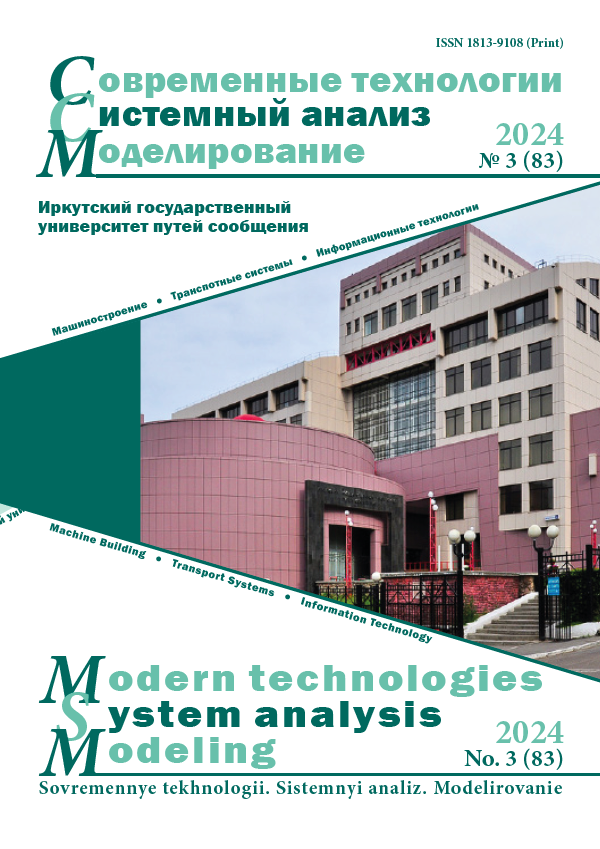Control of electric rolling stock taking into account operation modes of railway traction power supply system
Keywords:
electric rolling stock, traction power supply system, demand management, bandwidth, operating modes, instant loadingAbstract
The development of digital technologies in railway transport makes it possible to overcome a number of technological barriers associated with the limited capacity of the energy infrastructure by controlling electric rolling stock taking into account the operating modes of the railway traction power supply system in real time. The paper proposes an algorithm for controlling electric rolling stock in terms of changing the consumed power taking into account the operating modes, restrictions and in coordination with the regulators of the railway traction power supply system in real time. Control influence on the power reduction of the electric traction load can be obtained by numerical modeling based on a calculation scheme or a direct solution to a system of equations describing currents and voltages in the inter-substation zone of the traction power supply system. As a result of calculations for a single point in time, the value of the reduction in the power of the electric traction load was obtained taking into account the priority for fulfilling restrictions on the loading of contact network feeders by current and ensuring voltages in the traction network within acceptable limits. The reliability of the modeling results is confirmed by the convergence of the obtained results of calculating the modes of the electrified section with the experimental data. The implementation of the proposed approach will increase the capacity of the electrified section by increasing the reliability of the electric rolling stock and the traction power supply system of the railways due to the exclusion of abnormal modes of their operation. The presented technology for determining control actions for electric rolling stock taking into account mutual coordination and priority when exceeding the permissible limits of the parameters of the energy infrastructure is practically feasible and can be used within the framework of the «virtual coupling».
References
Об утверждении правил тяговых расчетов для поездной работы : распоряжение ОАО «РЖД» № 867р от 12.05.2016 (ред. 05.12.2023). Доступ из справ.-прав. системы «АСПИЖТ» в локал. сети.
ГОСТ Р 57670-2017. Системы тягового электроснабжения железной дороги. Методика выбора основных параметров. Введ. : 2018–05–01. М. : Стандартинформ, 2017. 52 с.
«Виртуальная сцепка» на Восточном полигоне: достигнутые эффекты и направления развития / А.И. Долгий, А.Г. Сахаров, М.А. Дежков и др. // Транспорт Российской Федерации. 2023. № 5-6 (108-109). С. 15–19.
Бушуев С.В., Гундырев К.В., Голочалов Н.С. Повышение пропускной способности участка железной дороги с применением технологии виртуальной сцепки // Автоматика на транспорте. 2021. Т. 7. № 1. С. 1–20.
Развитие технологий интервального регулирования движения поездов: итоги и перспективы / В.Е. Андреев, А.В. Пронкин, А.И. Долгий и др. // Транспорт Российской Федерации. 2023. № 1-2 (104-105). С. 6–12.
Об утверждении стратегии научно-технологического развития холдинга «РЖД» на период до 2025 года и на перспективу до 2030 года (Белая книга) : распоряжение ОАО «РЖД» № 769/р от 17.04.2018. Доступ из справ.-правовой системы АСПИЖТ в локал. сети.
Development of a Train Operation Power Simulator Using the Interaction between the Power Supply Network, Rolling Stock Characteristics and Driving Patterns, as Conditions / Y. Takeuchi, T. Ogawa, H. Morimoto et al. // Quarterly Report of RTRI. 2017. Vol. 58. Iss. 2. P. 98–104.
Пат. № 2629622 РФ. Система для контроля и регулирования мощности и энергии, расходуемой транспортной системой / В.А. Вербицкий, К.Г. Кисельгоф, И.О. Набойченко и др. № 2016116551 ; заявл. 27.04.2016 ; опубл. 30.08.2017, Бюл. № 25. 13 с.
Катыхин А. И., Нехороших И. Н. Разработка метода управления спросом на электроэнергию // Естественные и техниче-ские науки. 2019. № 4 (130). С. 190–193.
Mathematical model of the static reactive power compensator / T.R. Khramshin, G.P. Kornilov, A.A. Murzikov et al. // Interna-tional Conference on Actual Problems of Electron Devices Engineering (APEDE). Saratov, 2014. DOI 10.1109/APEDE.2014.6958287.
Стельмашенко А.В. Математическая модель для исследования влияния напряжения в контактной сети на процесс движения поездов // Актуальные проблемы железнодорожной науки глазами молодых исследователей : сб. материалов круглого стола, посвящ. Дню железнодорожника. М., 2022. С. 156–161.
Гамм А.З., Голуб И.И., Бершанский Р.В. Эффективный метод определения слабых связей в электроэнергетической си-стеме // Электричество. 2010. № 9. С. 31–37.
Coordinated voltage control of wind-penetrated power systems via state feedback control / H. Yassami, F. Bayat, A. Jalilvand et al. // International Journal of Electrical Power & Energy Systems. 2017. Vol. 93. P. 384–394. DOI 10.1016/j.ijepes.2017.06.014.
Novak H., Lešić V., Vašak M. Hierarchical Model Predictive Control for Coordinated Electric Railway Traction System Energy Management // IEEE Transactions on Intelligent Transportation Systems. 2019. Vol. 20. Iss. 2. P. 2715–2727. DOI 10.1109/TITS.2018.2882087.
Оперативное управление в системах электроснабжения железных дорог / В.П. Закарюкин, А.В. Крюков, В.А. Ушаков и др. Иркутск : ИрГУПС, 2012. 129 с.
Малыхина М.П., Герасимов Д.А. Мультиагентные системы искусственного интеллекта // Научные труды КубГТУ. 2018. № 3. С. 476–484.
Пшенокова И.А., Анчеков М.И., Макоева Д.Г. Архитектура мультиагентной когнитивной системы процесса принятия решений в интеллектуальных средах обитания // Изв. Кабардино-Балкар. науч. центра РАН. 2018. № 4 (84). С. 28–32.
Баранов Л.А., Сафронов А.И., Сидоренко В.Г. Планирование движения поездов в интеллектуальных транспортных системах // Надежность. 2022. Т. 22. № 3. С. 35–43.


